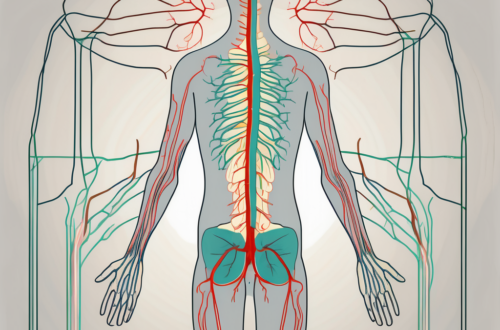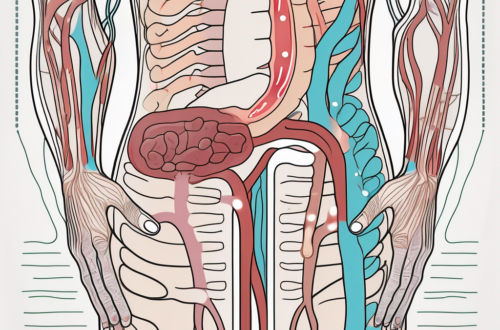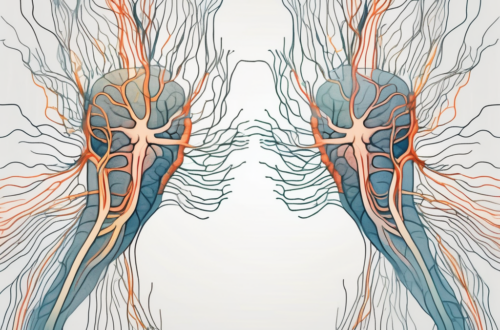The parasympathetic nerve plays a crucial role in bladder function, regulating its control and coordination. By understanding the anatomy and function of the parasympathetic nervous system, as well as its connection to the bladder, we can gain insight into the various disorders and treatment options related to this complex system.
Anatomy of the Parasympathetic Nervous System
The parasympathetic nervous system is one of the two divisions of the autonomic nervous system, along with the sympathetic nervous system. It consists of a network of nerves that originate from the cranial and sacral regions of the spinal cord.
The parasympathetic nerve fibers, known as preganglionic fibers, emerge from the cranial nerves, including the vagus nerve, and the spinal nerves in the sacral region. These fibers extend to various organs, including the bladder, where they synapse with postganglionic nerve fibers.
The postganglionic fibers release a neurotransmitter called acetylcholine, which binds to specific receptors in the target organ, such as the bladder, to initiate the parasympathetic response.
The Parasympathetic Nerve: A Brief Overview
The parasympathetic nervous system is responsible for promoting rest and relaxation in the body. It counterbalances the effects of the sympathetic nervous system, which triggers the “fight or flight” response.
Activation of the parasympathetic nerve slows heart rate, constricts pupils, stimulates the production of saliva, and increases digestive activities. These responses are essential for maintaining a healthy and properly functioning bladder.
The parasympathetic nerve also plays a role in other bodily functions, such as regulating respiratory rate, promoting sexual arousal, and aiding in digestion. It is a crucial component of the body’s overall homeostasis.
The Connection Between the Parasympathetic Nervous System and the Bladder
The parasympathetic nerve plays a pivotal role in bladder control by regulating its filling and emptying processes. When the bladder is empty, the parasympathetic nervous system is mostly inactive.
As the bladder fills with urine, the parasympathetic nerve is activated, prompting the release of acetylcholine. This neurotransmitter binds to muscarinic receptors in the bladder wall, leading to contractions of the detrusor muscle and relaxation of the urethral sphincter.
This coordinated action allows for efficient emptying of the bladder during urination while preventing involuntary leakage. The parasympathetic nerve also signals the brain when the bladder is full, creating the sensation of needing to urinate.
In addition to its role in bladder control, the parasympathetic nervous system is involved in other urinary functions. It helps regulate the production of urine by influencing the filtration and reabsorption processes in the kidneys.
Furthermore, the parasympathetic nerve contributes to the overall health of the urinary system by promoting blood flow to the kidneys, which is essential for their proper functioning. It also aids in maintaining the pH balance and electrolyte levels in the body’s fluids.
Overall, the parasympathetic nervous system and its connection to the bladder are vital for maintaining urinary continence, regulating urinary output, and ensuring the overall health of the urinary system.
The Parasympathetic Nerve’s Impact on Bladder Control
Bladder control is a complex physiological process that involves the interplay between the parasympathetic nervous system, other nerve pathways, and the muscles and tissues of the bladder.
The parasympathetic nerve plays a crucial role in regulating bladder control. It is responsible for stimulating the contraction of the detrusor muscle, a smooth muscle layer that lines the bladder wall. This contraction helps in the process of urination by pushing the urine out of the bladder.
However, the parasympathetic nerve’s impact on bladder control is not the only factor at play. Other nerve pathways, such as the sympathetic nervous system, also contribute to maintaining continence and preventing urinary leakage.
The Science Behind Bladder Control
Bladder control relies on a delicate balance between the excitatory signals sent by the parasympathetic nerve and the inhibitory inputs from other nerve pathways, such as the sympathetic nervous system.
The parasympathetic nerve stimulates the contraction of the detrusor muscle, a smooth muscle layer that lines the bladder wall. Simultaneously, the sympathetic nerves inhibit the detrusor muscle and contract the urethral sphincter, preventing urinary leakage when the bladder is not actively being emptied.
This intricate interplay of signals ensures that the bladder remains in a state of continence until a suitable time for voluntary urination arises.
Moreover, the parasympathetic nerve’s impact on bladder control is not limited to muscle contractions. It also influences the release of neurotransmitters and modulates the sensitivity of bladder receptors, further fine-tuning the process of urination.
How the Parasympathetic Nerve Influences Urination
When the time to empty the bladder arrives, the parasympathetic nerve sends the necessary signals to initiate the urination process.
Upon activation, the parasympathetic nerve causes the detrusor muscle to contract rhythmically, while simultaneously relaxing the urethral sphincter. This coordinated response enables the urine to be expelled from the bladder through the urethra.
It is important to note that the parasympathetic nerve’s influence on bladder control is not solely responsible for initiating urination. The brain also plays a crucial role in the process, as it receives signals from the bladder and decides when it is appropriate to urinate.
Once the bladder has been emptied, the parasympathetic nerve activity subsides, and the sympathetic nervous system takes over to maintain continence again.
In conclusion, the parasympathetic nerve’s impact on bladder control is essential for the proper functioning of the urinary system. Its role in stimulating the detrusor muscle and coordinating the process of urination ensures that the bladder can empty effectively while maintaining continence at other times. The interplay between the parasympathetic and sympathetic nervous systems, along with the involvement of the brain, adds complexity to the regulation of bladder control.
Disorders Related to Parasympathetic Nerve and Bladder Function
Various disorders can affect the proper functioning of the parasympathetic nerve and disrupt normal bladder control.
The parasympathetic nerve plays a crucial role in regulating the bladder’s activities, including the contraction of the bladder muscles and the relaxation of the urinary sphincter. When this nerve is not functioning properly, it can lead to a range of bladder dysfunctions.
Identifying Symptoms of Bladder Dysfunction
Bladder dysfunction can manifest in different ways, depending on the underlying cause and specific condition.
Individuals may experience urinary frequency, which means having to urinate more often than usual. This can be bothersome and disruptive to daily activities. Additionally, there may be a sense of urgency, where the need to urinate is sudden and intense, making it difficult to hold urine for long periods.
A weak urinary stream is another symptom that individuals may experience. This can make it challenging to fully empty the bladder, leading to a feeling of incomplete voiding.
Difficulty initiating or completing urination is also common in individuals with bladder dysfunction. It may take longer to start urinating or require straining to empty the bladder fully.
Urinary incontinence, the involuntary leakage of urine, is another prevalent symptom. This can range from occasional small leaks to a complete loss of bladder control. It can significantly impact an individual’s quality of life and self-esteem.
Recurrent urinary tract infections can also be a sign of bladder dysfunction. When the bladder does not empty completely, it creates an environment that is more susceptible to bacterial growth, leading to frequent infections.
Bladder spasms, characterized by sudden and intense contractions of the bladder muscles, can cause pain and discomfort. These spasms can be unpredictable and may lead to urinary urgency and incontinence.
If you experience any of these symptoms, it is important to consult with a healthcare professional for an accurate diagnosis and appropriate treatment options.
Common Disorders and Their Causes
Several disorders can disrupt the normal functioning of the parasympathetic nerve and impair bladder control.
One common disorder is overactive bladder (OAB), characterized by a sudden and frequent urge to urinate. OAB can result from an overactive parasympathetic nerve, which leads to involuntary contractions of the bladder. This can be caused by various factors, including age, hormonal changes, or neurological conditions.
Another condition is urinary retention, where the bladder is unable to empty completely. This can occur due to underactive parasympathetic nerve activity or obstruction in the urinary tract. In some cases, urinary retention can be caused by medications, nerve damage, or anatomical abnormalities.
Neurological conditions, such as spinal cord injuries, multiple sclerosis, or Parkinson’s disease, can also affect the parasympathetic nerve’s function and disrupt normal bladder control. These conditions can damage the nerve pathways that control bladder function, leading to various bladder dysfunctions.
It is essential to identify the underlying cause of bladder dysfunction to determine the most appropriate treatment approach. Treatment options may include lifestyle modifications, medication, pelvic floor exercises, or surgical interventions, depending on the specific condition and its severity.
Seeking medical advice and working closely with healthcare professionals can help individuals manage and improve bladder function, leading to a better quality of life.
Treatment Options for Parasympathetic Nerve-Related Bladder Issues
Treatment for parasympathetic nerve-related bladder issues aims to restore or optimize bladder function and improve quality of life. Parasympathetic nerve-related bladder issues can cause a range of symptoms, including urinary urgency, frequency, and incontinence. Fortunately, there are various treatment options available to address these issues and alleviate the associated discomfort.
Non-Surgical Treatments and Their Effectiveness
Non-surgical treatment options depend on the specific condition and may include lifestyle modifications, bladder training, and medications. These non-invasive approaches can be highly effective in managing parasympathetic nerve-related bladder issues.
Lifestyle modifications, such as limiting fluid intake or avoiding bladder irritants, can help manage symptoms in some cases. By making simple changes to their daily routines, individuals can reduce the frequency and urgency of their trips to the bathroom. Additionally, incorporating pelvic floor exercises into their daily routine can strengthen the muscles that control bladder function, leading to improved bladder control.
Bladder training techniques, guided by a healthcare professional, can gradually increase the bladder’s capacity and reduce urinary urgency. This involves scheduled voiding, where individuals learn to control their bladder by urinating at specific intervals. Over time, this can help retrain the bladder and improve overall bladder function.
Medications, such as anticholinergic drugs, can help relax the overactive bladder muscles, reducing urinary frequency and urgency. These medications work by blocking the action of acetylcholine, a neurotransmitter that stimulates bladder contractions. However, it is important to note that these medications may have side effects and should be prescribed and monitored by a healthcare professional.
Surgical Treatments and What to Expect
In cases where non-surgical treatments are ineffective or inappropriate, surgical interventions may be considered. Surgical treatments aim to address the underlying issue or improve bladder function, offering long-term relief for individuals suffering from parasympathetic nerve-related bladder issues.
Various surgical procedures can be performed to correct the underlying issue or improve bladder function. One such procedure is bladder augmentation, which involves enlarging the bladder using a section of the individual’s own intestine. This increases the bladder’s capacity and reduces the frequency of urination. Another surgical option is urethral sling procedures, where a supportive sling is placed under the urethra to provide additional support and prevent leakage. Additionally, sacral neuromodulation, a procedure that involves implanting a device to stimulate the sacral nerves, can help regulate bladder function.
Before opting for any surgical procedure, it is important to discuss the potential benefits, risks, and expected outcomes with a urologist or urogynecologist. They will evaluate the individual’s specific condition and recommend the most suitable surgical approach. Additionally, they will provide detailed information about the procedure, including the recovery process and any potential complications.
Postoperative care and rehabilitation may be necessary, depending on the specific procedure performed. This may include pain management, physical therapy, and follow-up appointments to monitor progress and address any concerns. It is crucial for individuals to closely follow their healthcare provider’s instructions during the recovery period to ensure optimal healing and long-term success of the surgical intervention.
The Future of Bladder Function Research
Ongoing research in bladder function aims to improve our understanding of the parasympathetic nerve’s role and develop innovative treatments for bladder dysfunction.
The study of bladder function is a complex field that involves various disciplines, including neurophysiology, urology, and molecular biology. Scientists and medical professionals are dedicated to unraveling the mysteries of the bladder and finding effective solutions for individuals with bladder dysfunction.
Current Research Trends in Bladder Function
Scientists and researchers are exploring various avenues of research to better comprehend bladder function and develop targeted therapies.
Advances in neurophysiology have allowed researchers to delve deeper into the intricate workings of the parasympathetic nerve, which plays a crucial role in bladder control. By studying the neural pathways and signaling mechanisms involved, scientists hope to identify potential therapeutic targets for the treatment of bladder dysfunction.
Imaging techniques, such as magnetic resonance imaging (MRI) and positron emission tomography (PET), have provided valuable insights into the structural and functional changes that occur in the bladder during different stages of bladder dysfunction. These imaging modalities allow researchers to visualize the bladder in real-time and observe how it responds to various stimuli.
Furthermore, molecular biology has contributed significantly to our understanding of the molecular mechanisms underlying bladder control and dysfunction. By studying the genes and proteins involved in bladder function, researchers can identify potential biomarkers for early diagnosis and develop targeted therapies.
Another exciting area of research is the investigation of stem cells and regenerative medicine for bladder dysfunction. Researchers are exploring the potential of using stem cells to repair damaged nerves and tissues in the bladder, offering the possibility of restoring normal bladder function and improving the quality of life for individuals with bladder-related disorders.
Potential Breakthroughs in Bladder Dysfunction Treatment
The future holds promise for breakthroughs in bladder dysfunction treatment, with researchers exploring various avenues to improve patient outcomes.
Novel drug therapies are being developed to target specific molecular pathways involved in bladder dysfunction. These drugs aim to restore the balance of neurotransmitters and signaling molecules in the bladder, thereby improving bladder control and reducing symptoms.
Innovative surgical techniques are also being explored to treat bladder dysfunction. Minimally invasive procedures, such as nerve stimulation and bladder augmentation, offer less risk and faster recovery times for patients. Surgeons are continually refining these techniques to optimize outcomes and minimize complications.
Advancements in bioengineering and neuroprosthetics may revolutionize bladder control devices. Researchers are working on developing implantable devices that can interface with the nervous system, allowing for precise control of bladder function. These devices have the potential to restore normal bladder control and significantly improve the quality of life for individuals with bladder dysfunction.
In conclusion, understanding the role of the parasympathetic nerve in bladder function sheds light on the complex mechanisms involved in bladder control. By recognizing the disorders that can disrupt this delicate balance and exploring the available treatment options, individuals can effectively manage bladder dysfunction and improve their quality of life. It is crucial to consult with a healthcare professional for an accurate diagnosis and personalized treatment plan tailored to each individual’s specific needs.
Ongoing research in bladder function holds promise for future breakthroughs and innovative therapies, offering hope for those affected by bladder-related disorders. The collaborative efforts of scientists, medical professionals, and engineers are driving advancements in our understanding of bladder function and the development of effective treatments. With continued research and technological advancements, we can look forward to a future where bladder dysfunction is better understood and managed, ultimately improving the lives of millions of individuals worldwide.





